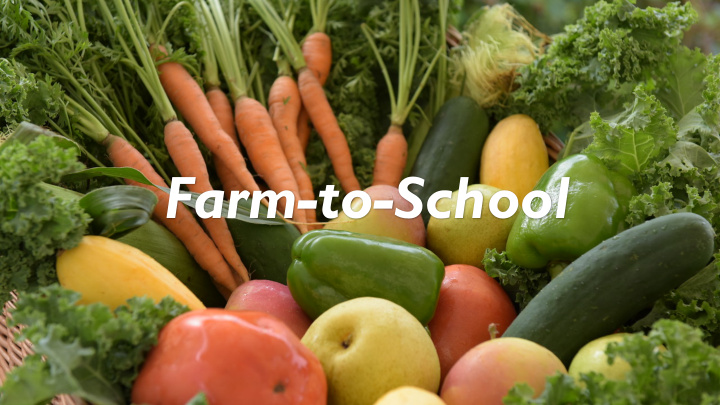



Farm-to-School
1 IN 13 CHILDREN DO NOT CONSUME ENOUGH FRUITS AND VEGETABLES ¡ How does Farm to School Work to Bridge that Gap… When schools offer ¡ school gardens, 44.2 percent of students eat more fruits and vegetable When schools serve ¡ local food, 33.1 percent of students eat more fruits and vegetables
INCLUDES ONE OR MORE OF THE FOLLOWING: ¡ Procurement: Local foods are purchased, promoted, and served in the cafeteria. ¡ Education: Students participate in the education activities related to agriculture, food, health and nutrition. ¡ School Gardens: Students engage in hands-on learning through gardening.
Farm-to-School on the Rise
STEPS IN FARM-TO-SCHOOL ¡ 1. Form a team and collaborate ¡ 2. Establishing a vision ¡ 3.Define your definition of local ¡ 4. Defining your goals ¡ 5. Procurement ¡ 6. Promoting and marketing your program
STEP 1: FORM A TEAM AND COLLABORATE ¡ School Food Service Staff ¡ Educators ¡ Administrators ¡ Local Farmers and producers ¡ Students ¡ Parents
STEP 2: ESTABLISH YOUR VISION ¡ What is behind your decision to establish a farm-to-school program? Why does your community value a community food systems approach? ¡ What benefits will a farm-to-school program bring to your students, school district, and community? ¡ What is your long-term vision for a thriving program?
Step 3: Define your definition of local Example: New York Pennsylvania New Jersey
STEP 4: DEFINE YOUR GOALS • PURCHASE LOCAL PRODUCE • SCHOOL GARDEN
STEP 5: FOCUS ON PROCUREMENT CONTINUE TO DEFINE YOUR DISTRICT’S GOALS How often does your District want to showcase local? The next few • Harvest of the month ¡ steps in Farm-to- Ingredients Substitution ¡ School, will be Seasonal Cycle Menu ¡ coordinated with Salad Bar ¡ food services. Themed Menus for Special Events ¡
STEP 6: INVESTIGATE WHAT YOU ARE ALREADY PURCHASING AND DETERMINE IF IT IS LOCAL ¡ Do not hesitate to reach out to your distributors. If produce is available locally, distributors will typically purchase close to home. ¡ Bread ¡ Milk
USDA DEPARTMENT OF DEFENSE FRESH FRUIT AND VEGETABLE PROGRAM ¡ Allocate a portion of your commodity dollars to the DOD program ¡ Their website will indicate if the produce is local and as well provide farmer information
Fresh Fruit and Vegetable Program • Elementary Schools with 50% or more students eligible for Free and Reduced-Price Meals, that participate in the NSLP • Usually application is available in March and due in April
WHAT IS JERSEY FRESH? ¡ Established in 1984, by the New Jersey Department of Agriculture, the Jersey Fresh logo was designated to inform consumers which fruits and vegetables were grown in the Garden State. So, if you see the logo on it guarantees that piece of produce was grown in New Jersey!
New Jersey is the Garden State New Jersey is a National Top Ten Producer of Fruits and Vegetables
STEP 7: HOW TO SEARCH FOR LOCAL PRODUCE IN YOUR AREA VISIT: • WWW.FIN DJERSEYFR ESH.COM NJ Growing Season: April - December
DURING THE WINTER MONTHS ¡ Frozen – Frozen Blueberries ¡ Canned – NJ T omato Sauce ¡ Dehydrating
SELF-OPERATED FOOD SERVICE PROGRAMS-PURCHASING ¡ A) SFAs may apply a geographic preference when procuring unprocessed locally grown or locally raised agricultural products ¡ Unprocessed means agricultural products retain their inherent characteristics ¡ SFA has discretion to determine local area to which this option will be applied
SELF-OPERATED FOOD SERVICE PROGRAMS-PURCHASING ¡ Solicitation must clearly outline how responses will be evaluated and scored, including geographic preference ¡ Application of preference option must leave an appropriate number of qualified firms, given the nature and size of procurement
Contract Food Service Management Companies: Purchasing If your contract includes language which allows your FSMC to procure on behalf of the Food Service Program, then your FSMC will handle purchasing for your Farm to School Program if food is used as a part of the Food Service Program.
GROW YOUR LOCAL PRODUCE ¡ Container Garden ¡ Fruit Tree ¡ Herb Gardens ¡ Greenhouses ¡ T ower Garden
STEP 8: ESTABLISH A ROTATION OF WHEN YOU PLAN ON SHOWCASING YOUR LOCAL FRUITS AND VEGETABLE. ¡ Harvest of the Month ¡ Ingredient Substitution ¡ Season Cycle Menu ¡ Salad Bar ¡ Themed Menus for special events
STEP 9: LET’S HAVE FUN WITH YOUR ROTATION DECIDE HOW TO MENU YOUR LOCAL PRODUCE!
STEP 10: NOW FOR THE EDUCATION! ¡ Once you have established which local produce you will be purchasing, it is accessible to partner with the rest of your community.
STEP 11: MARKETING, MARKETING AND MORE MARKETING Send email blast home when ¡ you will be showcasing your local produce Include nutrition facts and ¡ farmer information A) Hang up flyers in the ¡ cafeteria
GO ABOVE AND BEYOND ¡ Taste testing with students ¡ Give them a sticker for trying the local fruit and vegetable
PARTNER WITH THE CLASSROOMS. TEACH THE STUDENTS THE HEALTH BENEFITS OF THE PRODUCE WHILE TASTING THEM
WHY LOCAL? ¡ Farm-to-School enriches the connection communities have with fresh, healthy food and local food producers by enhancing food purchasing and education practices at schools and early care and education sites.
FARM-TO-SCHOOL WORKS TO CREATE POSITIVE SCHOOL AND COMMUNITY BENEFITS
FARM-TO-SCHOOL WORKS TO STIMULATE LOCAL AND REGIONAL ECONOMIES
Sustainable Jersey Certified Districts receive: • Promoting locally grown foods-10 points • School Gardens-10 points
Grants The USDA Farm-to-School Grant Program 1) December 13 th 2019-2020 Sustainable Jersey for Schools Grants Program 1) Due October 31 st Salad Bars to Schools 1) No Due Date
RESOURCES ¡ A) Schoolnutrition.org ¡ B) https://www.fns.usda.gov/cfs/farm-to-school- resources-1 ¡ C) FarmtoSchool.org ¡ D) Farmtoschool.nj.gov
Recommend
More recommend